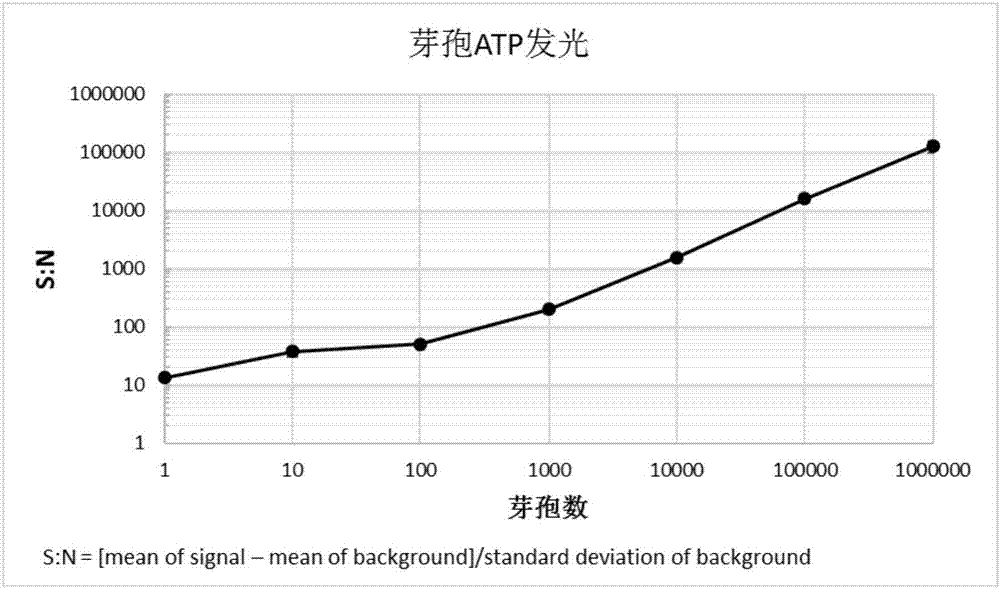Method and biological indicator for quickly determining sterilizing effect
A biological indicator, sterilization effect technology, applied in chemiluminescence/bioluminescence, analysis by chemical reaction of materials, measurement devices, etc., can solve the problems of low accuracy and long evaluation time, and achieve high accuracy degree of effect
- Summary
- Abstract
- Description
- Claims
- Application Information
AI Technical Summary
Problems solved by technology
Method used
Image
Examples
Embodiment 1
[0033] Example 1 Preparation of bacterial spore suspension
[0034]The preparation of the spore suspension refers to the preparation method of the bacterial spore suspension in "Disinfection Technical Specifications (2002 Edition)". (1) Take the freeze-dried strain tube, open it under aseptic operation, and add an appropriate amount of nutrient broth medium. Take a test tube containing nutrient broth, add a little strain suspension dropwise, and incubate at 37°C for 18-24h. Use an inoculation loop to take the bacterial suspension of the first generation culture, streak inoculate it on a nutrient agar medium plate, and incubate at 37°C for 18-24h. Pick typical colonies from the above-mentioned second-generation culture, inoculate them in nutrient broth medium, and cultivate them at 37°C for 18-24 hours to form the third-generation culture. (2) Take the 18-24h nutrient broth culture of the 3rd-5th generation, inoculate it on the surface of the nutrient agar medium in the Roche...
Embodiment 2
[0035] Example 2 Preparation of spore ATP detection reagent
[0036] Follow the steps below to prepare the spore ATP detection reagent:
[0037] (1) Use freshly prepared high-purity water to prepare 100mL 150-250mM N-2-hydroxyethylpiperazine-N'-2-ethanesulfonic acid (HEPES) solution; add 0.15-1.20g chlorhexidine acetate, 1.5-2.5 mL Triton X-100 (Triton X-100), 0.3-0.5g magnesium chloride hexahydrate, 0.7-1.0g dihydrate ethylenediaminetetraacetic acid disodium salt (EDTA); use 1M sodium hydroxide to adjust the pH of the solution to After 7.5, use a 0.22 μm filter membrane to filter and sterilize; add 20-50 mg of luciferase (Sigma) and 100-200 mg of D-luciferin (Sigma), dissolve, and store at -20°C.
[0038] Or (2) Use freshly prepared high-purity water to prepare 100mL of 150-250mM N-2-hydroxyethylpiperazine-N'-2-ethanesulfonic acid (HEPES) solution; add 0.06-0.10g hexadecyltrimethyl Ammonium bromide (CTAB), 0.15-1.20g chlorhexidine acetate, 1.5-2.5mL Triton X-100 (Triton X-1...
Embodiment 3
[0040] Example 3 Spore ATP detection reagent detects spores
[0041] Get the spores of Geobacillus stearothermophilus (ATCC 7953) prepared in Example 1, use sterile water to dilute into different concentrations, add different concentrations of spore suspensions in the 96-orifice plate, so that the spores in each hole are respectively 0, 1, 10, 100, 1000, 10 000, 100 000 and 1 000 000, and then add the spore ATP detection reagent in Example 2, and use a multifunctional plate reader (PerkinElmer) to detect the luminescence value. figure 1 Shown is the ATP luminescence of different amounts of spores. The S:N (signal-to-noise ratio) of the luminescence is positively correlated with the amount of spores. The more spores, the greater the S:N (signal-to-noise ratio). When the number of spores is 1, the S:N (signal-to-noise ratio) is still greater than 10, indicating that the spore ATP detection reagent of the present invention has ultra-high sensitivity for detecting spores.
PUM
 Login to View More
Login to View More Abstract
Description
Claims
Application Information
 Login to View More
Login to View More - R&D
- Intellectual Property
- Life Sciences
- Materials
- Tech Scout
- Unparalleled Data Quality
- Higher Quality Content
- 60% Fewer Hallucinations
Browse by: Latest US Patents, China's latest patents, Technical Efficacy Thesaurus, Application Domain, Technology Topic, Popular Technical Reports.
© 2025 PatSnap. All rights reserved.Legal|Privacy policy|Modern Slavery Act Transparency Statement|Sitemap|About US| Contact US: help@patsnap.com



